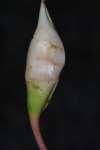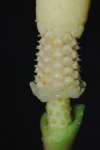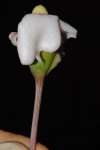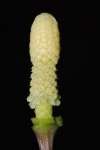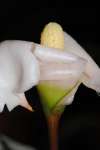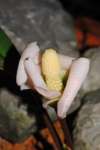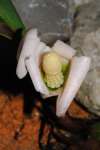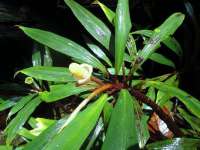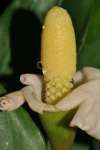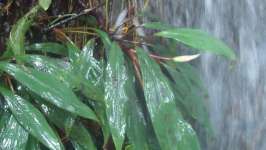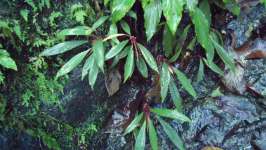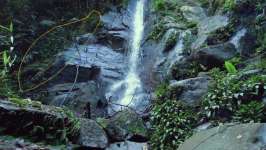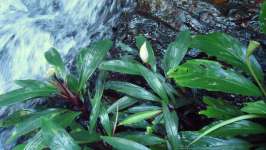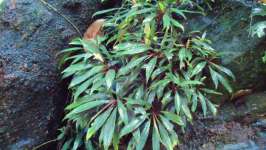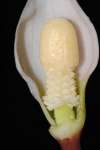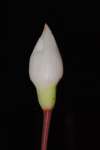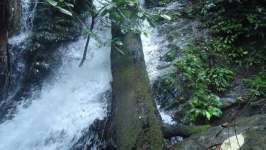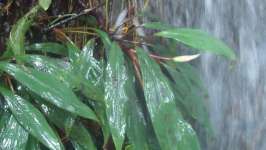Bucephalandra goliath S. Y. Wong & P. C. Boyce, Wiildenowia 44: 169, Fig. 10 & 23L (2014).
Holoype: Indonesian Borneo, Kalimantan Barat, Kabupaten Melawi, Kecamatan Nanga Pinoh, Jalan 28, 8 km E of Kampong Nyangai, Landau Garong, logging road 25 km S of Nanga Pinoh, Ulu Sungai Reret and Ulu Sungai Sentulang, 00=A1=C634'31.9"S, 111=A1=C656'30.8"E, 16 Oct 2012, K. Nakamoto AR-4040 (BO!; isotypes: SAR!, SBC!, SING!).
Diagnosis —The leaf blades of Bucephalandra goliath are most similar to those of B. ultramafica, but B. goliath differs from B. ultramafica in its overall habit, having considerably elongated pendent naked stout stems. The spadix of B. goliath is notable by the bluntly cylindrical appendix clothed with large staminodes, and by the different morphology of the staminate flowers as compared with B. ultramafica.
Description — Robust erect to pendulous obligate rheophytic herbs up to 15 cm tall but occurring as pendent masses to over 1 m long. Stem initially erect and obscured by sheathing leaf bases, later (on old plants), mostly naked with tufts of leaves at tips, stems pendulous to 50 cm or more with active tips ascending, older stems branching repeatedly to form curtains hanging for 1 m or more. Leaves in tufts of 10 or more at tips of active shoots; petiole 5 – 6 cm long =A1=BF c. 2.5 mm in diam., longitudinally ridged, adaxially canaliculate, reddish brown, sheathing at extreme base, wings extended into a very narrowly triangular ligular portion to 4 cm long; blade narrowly elliptic, 10 – 15 cm long =A1=BF 1 – 1.5 cm wide, rather thickly coriaceous, semi-glossy medium green adaxially, pale yellow-green abaxially, base cuneate, apex acute to slightly acuminate, apiculate for c. 1.5 mm, margin usually straight and slightly recurved; midrib abaxially and particularly adaxially prominent, red abaxially; primary lateral veins c. 4 on each side, diverging at c. 30=A1=C6 and running to a marginal vein; interprimary veins alternating with primaries and scarcely differentiated; secondary venation adaxially =A1=BE obscure, abaxially fine and + following line of interprimaries; tertiary venation obscure. Inflorescence solitary, very seldom 2 together separated by a prophyll; peduncle exceeding petioles, 4.5 – 8 cm long =A1=BF c. 2 mm in diam., somewhat compressed, conspicuously longitudinally sulcate, pale red, with distal-most expanded portion below spathe medium green. Spathe ovate, not constricted, 3.5 – 5.5 cm long; lower spathe funnel-form, green, persistent; limb inflating at pistillate anthesis, gaping to produce a narrow slit-like opening along upper =A8=F8 of spathe limb, caducous by fragmenting into large semi-coherent pieces at staminate anthesis, white, apiculate for c. 2 mm. Spadix 2 – 3.5 cm long; pistillate zone 4–5 mm long =A1=BF c. 3 mm in diam., with c. 4 spirals of pistils; pistils rhombic-globose, c. 0.5 mm in diam., milky green; stigma sessile, capitate, c. =A8=F6 diameter of ovary, papillate at anthesis; pistillodes absent; interstice with c. 2 rows of scale-like staminodes, these c. 2 mm long =A1=BF c. 2.5 mm wide, distal margin thickened and upward curving, staminodes initially erect, then spreading, white, later (post-anthesis) becoming green and persisting to cover developing fruit; staminate zone 5 – 6 mm long =A1=BF c. 5 mm in diam., consisting of c. 4 rows of flowers; staminate flowers cream; stamen comparatively large, c. 1 mm across; filament conspicuous; connective gibbose strap-shaped; thecae inserted ventrally, ellipsoid, c. 1 mm long =A1=BF c. 0.5 mm wide, smooth; thecae horns equalling associated theca, base areole-like, horn very short, spreading; appendix bluntly cylindrical, base abruptly tapering into staminate zone, 1.5 – 2 cm long =A1=BF 6 – 7 mm in diam., cream to medium yellow; appendix staminodes obpyramidal, truncate, 2 – 3 mm in diam., upper surface smooth and slightly glossy. Fruiting spathe not seen.
Ecology — Bucephalandra goliath occurs on granite waterfalls under perhumid lower hill forest at c. 250 m above sea level.
Distribution — So far known only from the area of Nanga Pinoh and Nanga Taman, where it is scattered and highly localized.
Etymology — Derived from Goliath of Gath (one of five city states of the Philistines), the giant Philistine warrior, and used in allusion to the robust and large stature of this species.
Remarks — The long stout pendent stems forming dense curtains of growth are immediately diagnostic. The leaf blade is also highly distinctive, although the leaf blades of Sabah Bucephalandra ultramafica are superficially similar.
Commercial names — =A1=AEGoliath=A1=AF, =A1=AEGoliathe=A1=AF, =A1=AEJupiter=A1=AF.



